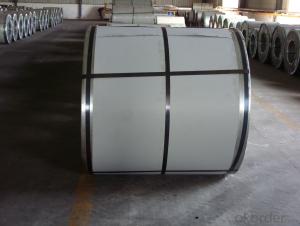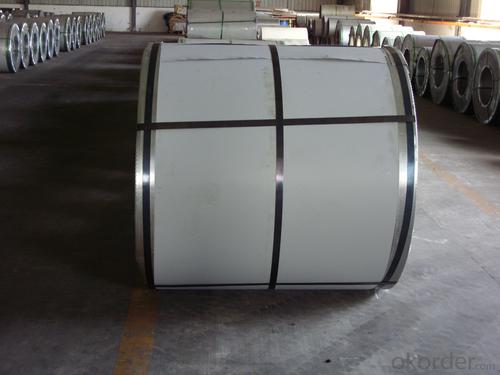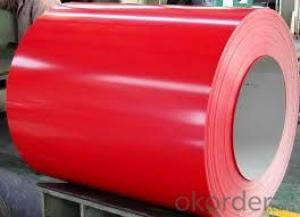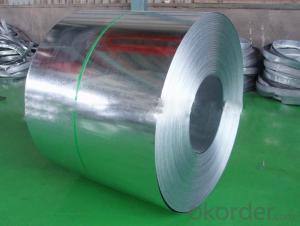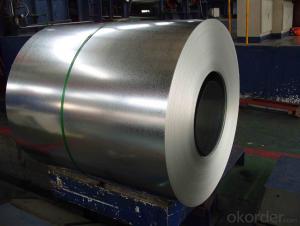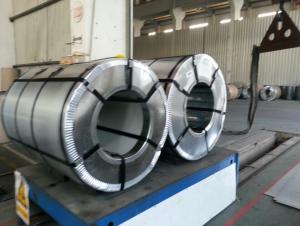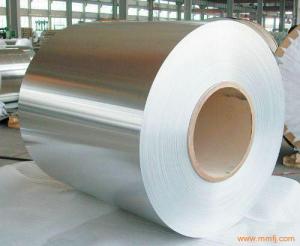HOT-DIPPED GALVANISED STEEL COIL
- Loading Port:
- China Main Port
- Payment Terms:
- TT OR LC
- Min Order Qty:
- -
- Supply Capability:
- -
OKorder Service Pledge
OKorder Financial Service
You Might Also Like
Prepainted Galvanized Steel Coils
With galvanized steel as base metal, after pretreatment (degrease and chemical treatment) and liquid dope with several layers of color, then after firing and cooling, finally the plate steel is called pre-painted galvanized steel. Pre-painted galvanized steel is good capable of decoration, molding, corrosion resistance. It generally displays superior workability, durability and weather resistance.
Brand Name: HBSTEEL
Specifications Of Hot Sell Prepainted Galvanized Steel
Thickness 0.23-1.2mm (BMT) |
Zinc Coating 80-275g/m2 |
Color According to RAL color fan |
Internal Diameter 508mm or 610mm |
Coil Weight 4-8MT |
Quality Commercial and structural quality |
Paint Polyester paint for topside, epoxy for reverse |
Standard JIS G 3312, ASTM A755M, EN 10169 |
Base Steel Grade SGCC,SGCD,DX51D+Z,DX52D+Z;S200GD,S220GD, S280GD,S350GD,CS,FS,SS |
Chemical Composition Of Prepainted Galvanized Steel
C | Si | Mn | P |
0.04-0.06% | 0.01-0.03% | 0.18-0.22% | 0.014-0.016% |
Technical Data Of Prepainted Galvanized Steel
Yield Strength | (Mpa) 280-320 |
Tensile Strength | (Mpa) 340-390 |
Elongation | 20%-30% |
Reverse Impact | 9J |
T-bending | ≥2T |
Pencil Hardness | ≥2H |
Duration Of Salt Spray Test | 500 H |
Bending At 180 Degree | No crack, purling and fraction |
Application Of Hot Sell Prepainted Galvanized Steel
It can be widely used in transportation, light industry, civil usage and farming. It is also the perfect building material in construction for making steel roofing,insulation panel, corrugate sheet, facade wall,shutters,T-bar and home appliance.
- Q: For the purpose of blade crafting. I need to heat treat this low quality steel i got.It's ASTM A36Is heat treatable and temperable?
- A36 is plain carbon structural steel. A36 could almost be considered junk steel. It is not suitable for cutting tools in any respect, as it is far to soft to hold an edge. A36 generally cannot be heat-treated, A36 can only be strengthened by cold-working, and even then, only up to about 60,000 psi. Heating the steel will only make it softer. The only real virtue of A36 is that it's easy to work with, it's easily cut and machined and it is very easy to weld. This is good for making steel structure, but not for knives. Probably the most popular material for knife blades is type 440C stainless. 440C is easy to work with in the un-treated state, and the heat treatment procedure is relatively simple.
- Q: Explain how you could make plastic sink and steel float?
- you can use the steel to make a hollow box, or a ship. There are thousands of steel ships floating in the oceans. plastic, specific gravity ranges from 0.6 to 2, so the higher density ones will sink. Here are some that will sink: Nylon (Polyamide) 1.15 g/mL Plexiglass (Polymethylmethacrylate or PMMA) 1.19 g/mL Lexan (Polycarbonate) 1.2 g/mL PVC (Polyvinyl chloride) 1.16-1.38 g/mL PETE (Polyethylene terephthalate) 1.38-1.39 g/mL .
- Q: What are the different types of steel coil slitting techniques?
- There are several types of steel coil slitting techniques, including rotary slitting, loop slitting, and double slitting. Rotary slitting involves using circular blades to cut the coil into narrower strips. Loop slitting is a method where the coil is fed through a looped pit, and the blades cut the coil as it passes through. Double slitting is a technique where two sets of slitting knives are used simultaneously to cut the coil into multiple strips at once. These techniques are used in various industries to create narrower and more manageable steel strips for further processing.
- Q: In the warehouse management system of steel coil
- Warehouse is an important component of enterprise material supply system. It is also the tache of enterprise material circulation and storage, and it also undertakes many functions of material management. Its main tasks are to keep the stock well, to be accurate, to be of good quality, to ensure safety, to prompt the people, to produce, to be considerate, to reduce costs, and to speed up capital turnover.
- Q: How are steel coils processed into finished products?
- Steel coils are processed into finished products through a series of steps that typically include uncoiling, leveling, cutting, and shaping. After uncoiling, the steel coils are passed through a leveling machine to remove any unevenness. Then, they are cut into specific sizes and shapes using different cutting techniques such as shearing or slitting. Finally, the cut steel pieces are shaped through various processes like bending, welding, and machining to produce the desired finished products.
- Q: For example, (and this is weird) if I were wearing a steel collar and I needed some way to remove it, with limited supplies.Force is difficult because it would be around my neck.Chemical cominations are great- but they have to use VERY common products. And I'm not sure what to use.Other ideas?
- There are plenty of ways to damage/weaken steel... shear or tensile force, fatigue, temperature, corrosion, grinding, etc... there are even dozens of ways to do each of the things I just listed. But in the case you suggested, with the steel being very close to skin... a simple pair of bolt cutters would probably be the easiest.
- Q: for my engineering project I have been asked to design a method of suspending a TV of weight 14Kg from a gantry, the TV must be 5m below the gantry. My team have decided to use as a suspension method a steel cylinder of outer diameter of 10cm and an inner diameter of 8, however we now need to work out both the max stress and strain and the actual stress and strain. and help would be useful
- In most engineering calculations we have to make some assumptions about ideal behavior of a material otherwise we would not be able to simplify our equations to manageable sizes. Your steel cylinder (which I'll call a pipe) is made of a certain type of steel. That steel type has property tolerances listed in a steel manual to help you know about your steel before you begin. You'll need to know the cross-sectional area of the pipe and the weight of the TV to determine an average stress on the pipe. Obviously the weight of the TV is the force it generates. The force is its mass x gravitational acceleration. Since we typically think of steel as an elastic material, we think of it stretching like a rubber band or a spring. You pull it down with a TV and it deflects a certain amount, and will return to its original length when the TV is removed. It is typical to assume that all steel, regardless of its strength, has the same value for this elastic property. It is commonly referred to as the elastic modulus. This value will help you determine what type of strain occurs under what type of stress. So, once you have the stress, you can get the strain by using the elastic modulus. Once you have the strain you can determine the deflection based on the pipe length. Having the steel properties will help you determine how close your TV comes to stressing the pipe to its yield stress. If you reach a yield stress, your steel will deflect, but when you take the TV off it will not return to its original shape. I hope I've helped outline some of the things you'll need to do for the project, I tried not to give away specifics so that you can actually engage your brain around the project. Enjoy, learn a lot, and realize that this skill could easily turn into a career where you are designing projects that when done correctly save people's lives every day of the year.
- Q: What is the process of uncoiling a steel coil?
- The process of uncoiling a steel coil involves placing the coil on a mandrel or a reel, then using a motorized or manual unwinding mechanism to slowly unwind the coil. The coil is typically fed through a straightening device to remove any bends or twists before it is further processed or cut into desired lengths.
- Q: What are the common applications of galvalume steel coils?
- Due to their unique properties and durability, galvalume steel coils are widely used in various applications. These coils are highly versatile and can be utilized in different industries. Some common uses of galvalume steel coils include: 1. Roofing: Galvalume steel coils are commonly employed in the construction industry for roofing purposes. The protective coating on these coils offers exceptional resistance against corrosion, making them an ideal choice for safeguarding roofs from harsh weather conditions and extending their lifespan. 2. Siding: Galvalume steel coils are also extensively used for siding applications in residential, commercial, and industrial buildings. The durability of these coils enables them to withstand external elements such as rain, wind, and sunlight without corroding or deteriorating. 3. Gutters and Downspouts: Galvalume steel coils are widely utilized in gutter and downspout systems. The corrosion-resistant properties of these coils ensure that gutters and downspouts remain functional and visually appealing for an extended period, eliminating the need for frequent replacements or repairs. 4. Appliances: Many household appliances, including refrigerators, ovens, and washing machines, incorporate galvalume steel coils. These coils' corrosion resistance and high heat reflectivity make them an excellent choice for manufacturing durable and energy-efficient appliances. 5. Automotive Industry: The automotive industry utilizes galvalume steel coils in the production of various parts such as body panels, chassis, and exhaust systems. The lightweight nature and corrosion resistance of these coils contribute to fuel efficiency and the overall durability of vehicles. 6. HVAC Systems: Heating, ventilation, and air conditioning (HVAC) systems often employ galvalume steel coils for components like ductwork and air handling units. The coils' ability to withstand high temperatures and resist corrosion ensures the longevity and efficiency of HVAC systems. 7. Agricultural Equipment: Galvalume steel coils are utilized in the manufacturing of agricultural equipment, including grain storage bins, barns, and sheds. These coils provide excellent protection against rust, ensuring that the equipment remains durable and reliable in agricultural environments. In conclusion, galvalume steel coils have a wide range of applications in various industries due to their corrosion resistance, durability, and ability to withstand harsh environmental conditions. These coils are highly sought after for their exceptional properties and are an essential component in many different sectors.
- Q: How are steel coils used in the appliance industry?
- Steel coils are used in the appliance industry to manufacture various components such as outer panels, frames, and internal structures of appliances like refrigerators, washing machines, and ovens. The coils are processed to create specific shapes and sizes, providing strength, durability, and stability to the appliances.
Send your message to us
HOT-DIPPED GALVANISED STEEL COIL
- Loading Port:
- China Main Port
- Payment Terms:
- TT OR LC
- Min Order Qty:
- -
- Supply Capability:
- -
OKorder Service Pledge
OKorder Financial Service
Similar products
Hot products
Hot Searches
Related keywords
